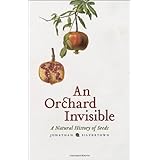
Average Reviews:

(More customer reviews)I'm always on the lookout for books about food plants in their natural state detailing where those foods originated, and how those plants became domesticated and changed over time. "An Orchard Invisible" (the title is from the Welsh proverb "a seed hidden in the heart of an apple is an orchard invisible") is just such a book and one of the best I have ever read.
Just to give you an idea of how densely packed this beautifully written book is with fascinating information about seeds--and by extension food and human culture--consider these gems from just two pages:
"MSG occurs naturally in fermented soybean paste, which is the source of miso and soy sauce used to flavor Chinese and Japanese dishes." (p. 170)
"Flavor sensations are a complicated confection created in the brain from the combined inputs of all five senses." (And not just five tastes on the tongue and the myriad aromas that the nose detects.) (p. 170)
There is a berry from the West African tree Synsepalum dulcificum that contains "a protein that interferes with taste receptors in the tongue and causes sour foods to taste sweet." Unfortunately efforts to take commercial advantage of this berry failed because only fresh berries will do the trick. (p. 171)
"...[W]hite chocolate...has the sugar and cocoa butter but not the pharmacological compounds found in normal chocolate..." On the other hand, cocoa powder contains "all the pharmacological constituents and sugar found in a bar of chocolate, but without the cocoa butter." Using this information you can test yourself to find out if you love chocolate for the "mouth feel" of the velvety cocoa butter (absent in a cup of cocoa) or because of the buzz you get from theobromine (absent in white chocolate). (p. 171)
Here's more: sunflower seeds and many other plant seeds grown in northern latitudes contain less saturated oils than the same plants grown farther south. Why? "The answer seems to be that at lower temperatures, seeds whose oil stores are held in saturated form have difficulty germinating...probably because...at low temperatures saturated oils are not liquid enough for germinating seeds to use them. Unsaturated oils...are apparently easier to metabolize at lower temperatures, as you might expect from their lower melting points." (p. 144)
How about this: "in the mid-1970s it was found that orthodox Hindus who had been quite healthy on a vegan diet in their native India began to suffer from a high incidence of metaloblastic anemia after living for some time in England consuming the same diet. The cause was traced to vitamin B-12 deficiency, which in India was prevented by insect contamination of grains." (pp. 168-169) Let me add an exclamation mark to that gastronomic irony!
And this: Plants use a light-sensing molecule called phytochrome that can differentiate between light that has passed through leaves and light that has not, so that they can "sense where their neighbors are and to adjust their own growth so as to avoid them. Many seeds also use phytochrome in the same way and will germinate in darkness, but not if exposed to light that has passed through a leaf." (p. 123)
Masting, which is the name for the trick nut-bearing trees use to control the animals that eat their seeds, is a diabolic scheme whereby the tree produces a bumper crop one year filling everybody's tummy, and then for the next x number of years produces not much at all, starving the little critters to death. In this way during the bumper crop years the extra nuts get buried and forgotten or the burier dies, and in the lean years the nuts germinate sans foragers. (See Chapter 8 "Ten Thousand Acorns.")
"More than three thousand species [of plants]...have a fatty wart called an elaiosome attached to them that attracts ants in search of food. Patrolling ants that find such seeds do not detach the elaiosome there and then, but carry the whole seed back to their nest, where it is buried. Once the seed has been stripped of its elaiosome in the ant nest, the ants dump it in a viable state on a trash pile where it can germinate." (p. 112)
Some tidbits:
Coffee is originally from Ethiopia; sunflowers were first cultivated in North America; ricin is found in castor beans (hopefully not in castor oil!) and "is more toxic than cobra venom and has no known antidote (p. 126); some seeds are shaped so that with the help of a little wind are able to screw themselves into the ground all the better to germinate (see Chapter 11: "Circumstance Unknown"); the double coconut of the coco de mer of the Seychelles can weigh 50 pounds; the oldest seed ever to germinate is a two-thousand year old date seed (p. 113).
Silvertown, who is professor of ecology at the Open University in England, sprinkles the text with snippets from history and lines of poetry from Burns, Dickinson and others pertaining to seeds and things relating to seeds. The text is further augmented with some delicate and precise black, white and grey illustrations by Amy Whitesides, making the book a little gem, a delight and a storehouse of delicious information.
Click Here to see more reviews about: An Orchard Invisible: A Natural History of Seeds
Click here for more information about An Orchard Invisible: A Natural History of Seeds

No comments:
Post a Comment